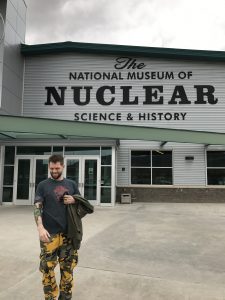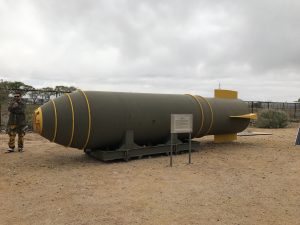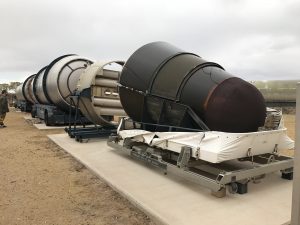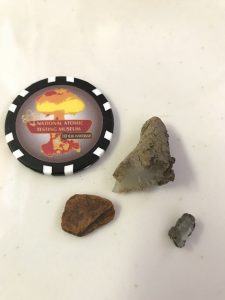Well, I’ve now stood on my second nuclear weapon ground zero. (the first I did on this trip)
April 1st was the Trinity Test Site open house, one of the two times a year that the White Sands Missile Range opens up to allow the public to visit. They used to open it up on the test anniversary date as well but, funny thing, people seem to have a hard time in the middle of the desert in mid-July. Heatstroke used to be part of the Trinity experience, which is why they have since moved the open house dates to the first Saturday in April and October. It also happened to be close enough to My Lovely Assistant’s birthday that we decided to make a roadtrip of it and collect a few more locations on the way. This first means flying to Albuquerque and, luckily, I already have operatives in place there.
In the long long ago, in the beforetime, Albuquerque was the administrative center for the nuclear weapons program. It’s where the Atomic Energy Commission sited their main office for the western half of the country; close enough to run up the hill to Los Alamos as needed, but a more transportation friendly place to, for example, bring personnel in for polygraph tests. The office is still there, but is now held by the Department of Energy/National Nuclear Security Administration (NNSA, not to be confused with NSA or NASA) and associated with Kirtland Air Force Base. Like any place that is important for long enough, they accumulate crap. Did I say crap? I meant to say “Smithsonian-grade museum archival materials”. And much like the old office and it’s archives in Las Vegas gave rise to the National Atomic Testing Museum (NATM), the Albuquerque office and Kirtland AFB spawned that National Museum of Nuclear Science & History. We decided to go hit this on the day before visiting Trinity.

It is always worth having a docent with you in these museums to point out the things you might have missed and give you the extra details that the placards are missing. In this case, we had University of New Mexico anthropology grad student, Martin Pfeiffer as our guest docent for the day. Martin’s research, among many things, involves how the nuclear weapons complex sold itself as safe and necessary to the public, to recruit prospective employees, and most importantly, to appropriators and procurement people with the purse strings. This means he spends A LOT of time going through magazine archives for advertisements from the 1950s & 1960s that are Jet Age/Mad Men masterpieces at their weirdest. Because take a moment, lean back in your chair, take a contemplative sip from your beverage of choice, and ask yourself “How would I sell nukes?” It’s a non-trivial one and that’s why he’s getting a anthropology PhD. I recommend any number of market research firms hire him promptly. Hell, hire him now and supplement the embarrassingly low grad student stipends that UNM pays.

Now you might ask how is NMNS&H different than the NATM. I can sum that up easily in two words: Delivery Systems. Where Vegas focuses on the work that happened at the Nevada Test Site, AKA blowin’ shit up real good, Albuquerque would like to tell you about all the weapons systems that Sandia built and Kirtland maintained. This means that it is bigger, because you need room for all that stuff and a lot of it isn’t small fiddly bits. We’re talking missiles and bombs of various size, and when you get to the big stuff, like planes, you have to go outside which is when I got incredibly giddy because they have a rocket garden. You see, I’m originally from Cocoa Beach, FL which means Kennedy Space Center was very easy to go visit on a whim. In particular, when I was little, before they fenced them all off and demanded you pay first, I constantly demanded that my parents take me to the KSC Rocket Garden to have a picnic under the X-15.

NMNS&H’s rocket garden, however, is all about delivery systems and I’ve never seen a collection like this before. Thor, Mace, Polaris, BOMARC, Titan, Snark…so many missiles. Looking at a Titan II on its side and getting close to the nose cone where the warhead would have gone, all you have to do is change the payload from military to civilian and you’ve got NASA’s Gemini program instead. Then there’s the bombs too large to fit in the building like the Mk17.
I want to pay special attention this bomb in the wake of the recent use of a MOAB in Afghanistan and the reporting that accompanied it that has some semantic problems around the phraseology “biggest bomb we’ve got”. “Big” can refer to physical size, or weight, or explosive yield (which is often related to but not on a 1:1 basis to weight and size). The 11 ton MOAB has greater explosive yield, but the MOP (Massive Ordnance Penetrator) is more massive at 15 tons, using that weight to sink through dirt, rock, cement before exploding with it’s smaller yield, but in the place you need it. As one weapons engineer once described it to me, “It’s puttin’ ass behind that blast.” The Mk17/24 bomb is the most massive bomb, nuclear or otherwise, that America ever made though only the second largest yield. The Mk41 holds that record at a 25MT yield, with it’s intended mission of obliterating hardened underground facilities by collapsing them with force from above, but only weighed a quarter as much as this 20 ton monster. Per pilot anecdote, when you dropped a Mk17/24 it wasn’t so much that that you’d released a bomb as the bomb had released you, with the plane rapidly jumping up in altitude.

Albuquerque was also home to a broken arrow incident with one of the Mk17s, as one accidentally got dropped from a bomber near Kirtland AFB when someone leaned against the wrong button on their B-36 as they headed back to base. Luckily, it wasn’t properly armed so just the conventional explosives went off on impact, terminally inconveniencing one cow rather than removing New Mexico’s largest city. The Army cleaned up the wreckage and decon’d the radiological contamination but, well, the Army is the Army, which is mostly made up of surly teenagers and twentysomethings that don’t really want to be there. If you look hard enough while hiking around in the hills you can find bits of the bomb they missed, which is something Martin did and is why my curio cabinet now contains a few fragments. To be fair, they are small fragments because it blowed up real good and even the Army can manage to notice and clean up large chunks.
We then got the pleasure of beers and fine New Mexican cuisine afterward. Courtesy of my other New Mexicans I had already learned the joys of what I refer to as New Mexican Background Chile Levels; there will always be some, the question is how much spicier would you like it above and beyond that. My personal spicy preference tends toward hot mustards and horseradish, not capsaicin, as my recent experiments with “chemical weapon bagels” will attest to. That said, New Mexico has made a convert of me with pork adovada. That was heavenly, I was lusting for more of it while at the Trinity Test Site, and as I’m sure friends will attest to, I have been whining about it’s absence from my life here in California ever since.
Next time: Trinity Test Site, Titan Missile Museum, and… umm… a discussion of the Jefferson Davis Highway.